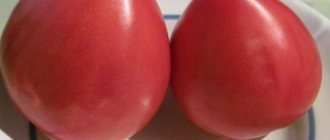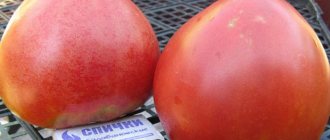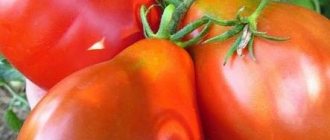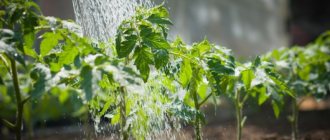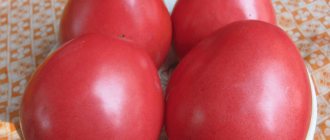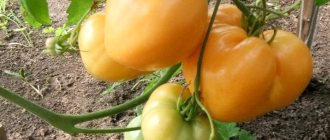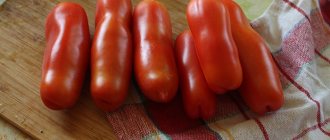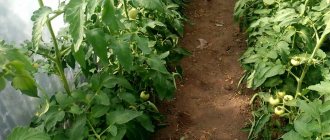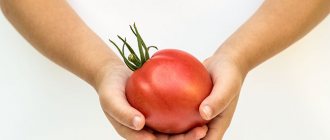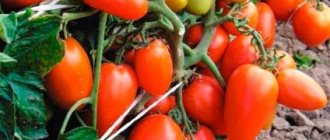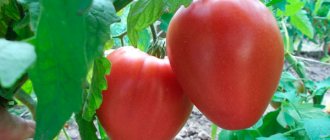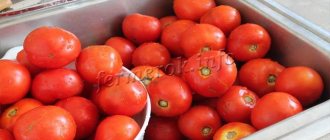» Vegetable growing » Tomatoes » Tomato variety Debut F1
0
2871
Article rating
The Debut tomato was bred in 2007 by MONSANTO HOLLAND BV. The variety is considered a first-generation hybrid, which means that the resulting seeds will not be able to produce a full harvest again. Tomatoes are successfully cultivated in Ukraine and Moldova, and in 2008 the variety was included in the State Register of Breeding Achievements of the Russian Federation.
- Advantages and disadvantages
- Growing seedlings
- Preparing seeds for sowing
- Planting seedlings in the ground
- Tomato care
- Errors during cultivation
- Top dressing
- Disease Prevention
- Harvest and storage
- Reviews from gardeners
Tomato variety Debut F1
Tomato Debut F1: variety description
The bushes of this tomato are of a determinate type, so the height of the shoots is small - no more than 0.6 m when grown in garden beds in open ground; in greenhouse conditions these plants can be higher - up to 0.75 m.
On a note!
The fruits of the Debut tomato ripen early - from the moment of germination of the seed material to the harvesting of the first tomatoes, about 3 months pass.
Tomato bushes of the Debut variety are not too strong, they should be formed into no more than 2 stems
so that the yield is as high as possible. Shoots are erect, medium leafy. The foliage is typical of tomatoes, narrow, elongated, with sharp tips, slightly corrugated, emerald in color.
This type of tomato should be fed moderately, otherwise green mass will actively develop on the plants to the detriment of yield. Since the bushes of this variety produce a large number of fruits, it is recommended to tie the shoots to strong supports so that the stems with fruits do not lie on the ground.
Ripe tomatoes are round in shape, approximately the same size, smooth, shiny, with characteristic ribbing at the base. The skin is quite compacted, glossy, bright red in color, and not prone to cracking. The weight of ripe tomatoes of the Debut variety is 200-250 g.
The harvested crop should be carefully transported to different distances; the shelf life of ripe tomatoes is average.
general characteristics
The debut of F1 is an ultra-early determinate hybrid, characterized by good yield and immunity indicators. Designed for planting both in open and protected ground, it has an extended fruiting period.
Description of fruits and bush
The fruits of the Debut F1 variety are round in shape, smooth and with a dent at the stalk, juicy and fleshy, the average weight, according to the description stated by the manufacturer, is 250 g. However, when grown in protected soil, you can achieve a weight of 300-400 g, as a rule, this is the first harvest.
The bushes grow up to 65 cm in an open garden bed and up to 75 cm in a greenhouse, after which growth stops.
Plants have fragile stems and therefore require additional fixation. The leaves are green and medium in size. About 5 fruits are formed on the fruit cluster.
Productivity
The hybrid is considered early ripening; the first tomatoes ripen within 55-60 days after planting the seedlings. Then it bears fruit from July to August.
On average, about 4.5 kg of crop is harvested from a bush.
To improve performance, it is recommended to form the plant into two stems. This means you will need to remove all the stepsons, in addition to the main stem (on which the inflorescence formed).
You should also avoid fertilizing, as this leads to excessive leaf formation and interferes with fruit growth.
():
Tomato is a crop that places increased demands on soil fertility and nutrition. The plant removes from the soil about 1% of nutrients from the mass of the crop, i.e. 100 kg of fruits remove 1 kg of nitrogen, phosphorus, potassium and about 20 different microelements from the soil. Growing tomatoes without fertilizing means depleting the soil and losing potential yield.
Disease resistance
The hybrid is immune to the following diseases:
- late blight, due to the early ripening period, the tomato does not have time to become infected with the fungus;
- verticillium and fusarium wilt;
- gray leaf spot;
- Alternaria stem cancer;
- mosaic.
In addition, the variety is characterized by resistance to temperature changes.
Application of fruits
Tomatoes of the Debut F1 variety are excellent for canning, making paste, juice and fresh consumption. They tolerate transportation well and can be stored for a long time at a temperature of 12-13 °.
Regions where the variety is grown
In the north of the country, it is better to grow tomatoes in greenhouses
The hybrid is suitable for cultivation in all regions of the country, with differences in the cultivation method.
For northern and central Russia (Urals, Siberia, Moscow region, Vladimir, Lipetsk, and other regions), Debut F1 tomatoes are best grown in a greenhouse. And in the south (Volgograd and Belgorod regions, Krasnodar Territory and others) - in open ground.
Area of application of fruits
The fruits of the Debut tomato are distinguished by their versatility of use - they are consumed fresh, do not crack when pickled and pickled, maintaining their good appearance. The excellent taste of tomatoes is also noted in purees, salads or lecho made from them.
Pests in the garden!
How to deal with cutworms How to get rid of wireworms How to deal with mole crickets
The size of Debut tomatoes allows them to be used in whole-fruit pickling and marinating.
Growing seedlings
Tomatoes are usually grown in seedlings; seeds are usually sown 50-55 days before the expected date of planting in a permanent place. They are treated with thiram, so there is no need to pre-soak them. The duration of growing seedlings depends on the time of year; in winter this period can be up to 9 weeks, in spring 6 weeks, in summer only 5 weeks are enough for the seedlings to grow. Plant seeds in cassettes or wooden boxes using a peat mixture. The seeds are sown to a depth of approximately 1 cm. The recommended temperature regime must be observed; at high readings on the thermometer, the seedlings stretch out and the stems weaken. If the stems are too powerful and the seedlings are not growing, experienced gardeners advise reducing the night temperature to 16 degrees.
Seedlings are dropped into a separate container when three leaves appear. After transplanting, it is better to feed them with complex mineral fertilizers, this will help them better tolerate the transplant and not be delayed in growth. Subsequent care of the seedlings consists of regular watering with warm, settled water and loosening the soil; a plastic fork is well suited for this.
Main advantages
The main advantages of the Debut tomato include:
- bushes - compact, small in size;
- fruit ripening period is early;
- excellent taste of the Debut tomato;
- the use of tomatoes is universal;
- the variety is resistant to major diseases that affect other tomato varieties;
- collected tomatoes can be transported over long distances.
There are no downsides to the Debut tomato variety; you just have to tie up the shoots, form bushes and annually purchase seed material from specialized stores.
Photo of tied tomatoes Debut
Landing
Tomatoes of the “Debut” variety are grown from seeds, which can be bought in specialized stores. Since the plant is a first-generation hybrid, the second-collected seeds do not produce a full harvest.
Growing seedlings
Sowing of seeds is carried out in early March in universal, prepared soil, which consists of:
- river sand (1/5 part);
- turf (1 part);
- humus (1 part);
- lowland peat (1 part);
- wood ash (1/5 part).
The planting mixture is treated with disinfectants (1% solution of potassium permanganate, fungicide) and thoroughly moistened.
The seeds are treated for disinfection (weak, 1% solution of potassium permanganate) and saturation with nutrients (Immunocytophyte, aloe juice extract, Zircon, Epin, Vitran-Micro).
In a container up to 15 cm high, seeds are sown in small grooves (depth up to 1 cm) in increments of up to 1.5 cm. After placing the seeds, the container is covered with glass or plastic film to create a greenhouse effect for the germination of seed at temperatures up to +27⁰C.
After two permanent leaves have formed on the plant, the seedlings are picked and planted one at a time in pots. One to two weeks before the intended planting, the plants are “hardened off”. To do this, the seedlings are taken out into the fresh air for 30-60 minutes with a gradual increase in the time spent outside.
Landing in the ground
1.5-2 months after sowing (early May), healthy seedlings are planted in open ground. It should be remembered that fertile, slightly acidic soil and well-lit areas are suitable for tomatoes. By this time, the seedlings have up to 6 leaves.
Separate holes are prepared for each plant, which are placed in a checkerboard pattern at a distance of up to 70 cm from each other. The beds for Debut tomatoes should be located in a slight shade, at a considerable distance from the potato planting areas.
When planting seedlings in the ground, a portion of mineral fertilizers for vegetable crops should be added to each hole.
Tomatoes Debut: further care
Caring for tomato bushes The debut is standard - watering, fertilizing, weed control and loosening the root zone.
Irrigation regime
Water the growing bushes of the Debut tomato variety as the soil dries with warm filtered water directly under the roots. Drops of moisture during watering should not fall on the foliage and shoots.
Loosening and weeding
After watering and rain, you should loosen the soil around the tomato bushes to remove the dry crust that forms on the surface of the soil. You should also control weeds so that they do not take away from the soil the nutrients necessary for tomato growth and fruit ripening.
It is recommended to form Debut tomato bushes into two stems, then remove all stepsons.
Feeding tomatoes for a good harvest
If all the necessary fertilizers are added to the seedling plot before planting, no further fertilizing is required for Debut tomato bushes. But straw or grass clippings should be placed around the bushes as mulch so that moisture from the soil evaporates slowly.
Basic soil requirements for planting
Tomatoes of the Debut variety love high soil moisture. Indicators of 70-80% are considered optimal. Also, the soil must be fertilized with minerals. On infertile soils, tomato grows slowly and yields remain low. Before planting seeds, the soil must first be plowed and treated with organic matter.
Hybrid tomatoes love porous and airy soil. At the same time, it must be dense. To normalize the density level, peat solutions or humus are used. The bushes are treated with mineral fertilizers immediately after they are planted.
Tomato Debut F1: reviews from those who planted
To grow a good harvest of tomatoes on your plot, you must choose the right variety, which is why it is so important to read reviews about the Debut tomato before planting it.
Tatyana, 44 years old, Moscow region: I have been growing this tomato in a greenhouse in my garden for several seasons. Although you have to buy seeds every year, it should be noted that their germination rate is close to 100%. Debut tomatoes do not require special care, you just need to tie up the shoots during the ripening of the crop. And the fruits of the Debut tomato are very tasty, good both for eating and for preservation.
Olga, 55 years old, Samara region: I am still quite an inexperienced vegetable grower, since I got a house with a plot a couple of years ago. There, my husband and I allocated a lot of space for a vegetable garden, where we grow tomatoes, cucumbers and bell peppers. My favorite variety of tomatoes is Debut, an unpretentious, early-ripening compact hybrid. There are no special problems with growing bushes of this variety; you just need to water them in time and tie up the shoots so that they do not fall to the ground under the weight of the fruit. The harvested crop is enough to eat throughout the season, and I also close a lot of spindles for the winter; my family eats them all until spring.
Dmitry, 60 years old, Volgograd region: I have had a garden plot for many years, I grow various vegetable crops on it every year. Tomatoes take up a lot of space in the garden. Every year I plant several different varieties, and periodically purchase and grow new tomato hybrids. But the Debut F1 tomato has been growing on my plot for 10 years now, and I have no intention of changing it to other early-ripening varieties. I like the early harvest of ripe produce, the fairly large size of the tomatoes, and the resistance of the hybrid to most diseases. And my wife prepares such delicious twists for the winter from the harvested crops, which all our household members enjoy eating.
Tomato Debut is one of the best early ripening hybrids of the determinate type.
The fruiting of this tomato is extended over time, the fruits are tasty and can be used for food and preservation. You can grow the Debut tomato in garden beds or in greenhouse conditions.
Growing experience: advantages and disadvantages of a hybrid variety
The advantages of the Debut F1 tomato are related to its versatility and unpretentiousness:
- The plant develops normally in unstable temperature conditions. Tolerates short-term drought.
- It has increased immunity to fusarium and verticillium. Due to its very early ripening, it avoids late blight.
- Hybrid bushes are compact. Thanks to this, you can plant tomatoes in close proximity to each other or with other nightshades.
- The first tomatoes ripen early.
- The crop bears fruit abundantly and for a long time. More than 4 kg of tomatoes are harvested from one determinate specimen.
- The taste and aroma of the fruits are at a high level. The structure allows them to look equally good in different types of food. Tomatoes can also be stored for a long time and can withstand transportation without problems.
- Some advantages of a hybrid become the reason for its disadvantages. To grow a neat tomato and reap a full harvest, you will need to carefully form the bush from the first days of life in the soil and carry out regular pinching. The plant also needs a garter to the support. The stem does not support heavy fruits.
Diseases and their prevention
Since tomatoes of this variety ripen as early as possible, problems with late blight do not arise at all. After all, the fruits are harvested much earlier. Also, the Debut variety exhibits resistance to herticillium, fusarium and Alternaria stem cancer.
If you plan to plant plants in a greenhouse, it is not recommended to reuse soil from old stocks. It may contain harmful microorganisms and diseases. And even a completely healthy bush can get sick.
Description
The plant is a determinate plant, a medium-sized bush, compact, 60 - 65 cm high. When grown indoors, you need to be prepared for the fact that the growth will be somewhat greater. The root system of the variety is very powerful, providing the crop with the necessary moisture and nutrition for growth and development. Tomato shoot formation is not too high, foliage is moderate. The leaves are medium in size, of normal type, with a slightly wrinkled surface, dark green in color. Inflorescence of intermediate type. Each fruit cluster generally produces up to 5 fruits. Pedicel with articulation.
The fruits of Debut look simply magnificent in appearance. Flat-round or round, with slight ribbing at the stalk, thick-walled and dense. The skin is thin, but durable, glossy. An unripe tomato is light green in color, without a spot at the stalk; when ripe, it becomes a rich red color. The pulp is fleshy, dense, holds its shape well when cut, multi-chambered. Seed nests, although numerous, 6 or more, are small in size. The taste is good to excellent. Tomatoes are large-fruited. The weight of the fruit, according to the State Register, is 210 - 230 grams. The originator claims from 200 to 220 grams. In warm regions, subject to proper agricultural practices, it is possible to grow specimens weighing 300–400 grams.
Harvesting tomatoes and storing them
Debut tomatoes have good keeping quality and the ability to withstand transportation over long distances.
It is recommended to collect tomatoes several times a week. Moreover, it is best to do this in the morning, when the harvest is of the highest quality. If the goods need to be transported in the future, they need to be picked while still brown. To keep the fruits intact, it is important to observe the temperature regime. The optimal temperature is considered to be 12-13 degrees Celsius.
Reviews
Lyboff, Moscow, experienced summer resident
I usually avoid hybrids; I still remember the failure with one of them - the advertised “Dutch”. They picked 2 tomatoes of uncertain taste, and the bush quickly died.
Therefore, when the seller began to persuade me, along with the usual varieties of tomatoes, to buy the Debut hybrid, I bought it, just to get rid of it.
The GOST-treated seeds all sprouted. The seedlings also turned out to be extremely successful: strong, with powerful leaves, and not tall. In May I put her under film. Unfortunately, there were frosts at the end of May, but Debut survived. By the way, the only one of all planted on the street. The bushes are no more than 70 cm, I didn’t even tie them up. I worked it down to the first flower cluster.
The harvest is quite decent: 8-10 fruits per bush. The weight of a tomato is from 120 to 250 g. But the most important thing is the taste! Well, I never thought that hybrids could be tasty! So the manufacturer did not disappoint or deceive. I recommend.
Olenka_83, Kirov
I always try to buy hybrids or professional series varieties. Of course, they are more expensive, but there is a guarantee that everything that is advertised on the package is true. So I bought the Debut F1. I liked the tomatoes in the picture – big and red.
Mine grew smaller - the largest was 200 grams, but they were very early - already in mid-July they were turning red on the branches. The taste is normal, not sour. And, and most importantly, there is no need to stepchild. So they almost grew on their own. I just tied it to a peg so that it wouldn’t fall from such large fruits.
Plant it, you won't regret it. Moreover, the hybrid is new and manufacturers still comply with all standards.
Sergey Egorovich, pos. Dalny, 72 years old
I really love and always trust seeds from Seminis. I always try to order new items from them by mail. So I bought the seeds of the hybrid Debut F1. I liked the tomatoes, all the seeds sprouted (this always distinguishes Seminis). I planted the seedlings in the greenhouse at the beginning of May, because we may have frosts in early June.
The tomatoes ripened very early, I wasn’t expecting them yet. Not to say that there were too many apples on the bush, but there was enough for everyone to eat early, when they wanted to. And by the way, they gave us tomatoes all summer afterwards. I highly recommend this hybrid.
Preparing seeds for sowing
The process includes 2 stages:
- disinfection in a solution of potassium permanganate;
- treatment with nutrients for at least 24 hours (Vitran-Micro, Immunocytophyte).
The box should be about 10-15 cm in height.
Place one seed in a hole, then cover the box with film to maintain constant humidity while the seeds germinate.
The optimal temperature for germination is 23 -27°. With the formation of 2 true leaves, the seedlings are planted, transplanted into peat or ordinary pots with updated soil.
A week before planting in the beds, the seedlings should be hardened off; to do this, they are taken out into the fresh air, first for an hour, and then the time is increased.
